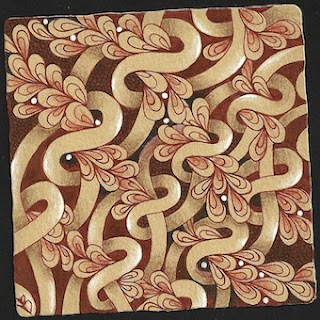I have a long-standing interest in languages and linguistics and in color, so of course I'm curious about how various languages refer to colors. Here is a bit of what I've learned, paired with some more-or-less appropriate artwork!
 |
| Primitive languages have only two color words and they are for black and white, or - more accurately - dark and light. |
 |
| If a language has only three words for colors, they are for black, white, and red. This is because red is so closely associated with life and death. |
 |
| Color terms are added in a fixed order as a language evolves. Next to arrive are words for green and yellow, one or the other, and then the other. |
 |
| After yellow and green is blue. |
 |
As languages develop they next add |
 |
| (No, this isn't my art, but it gets the point across nicely!) Irish apparently has two words for green. Glas denotes the green color of plants and the gray-green of the sea, while uaithne describes the artificial greens of dyes, paints, and such. Apparently this distinction is made even if the hues are identical. It seems it's not so much about the color itself, but about how it came to be. |
 |
| And there you have a brief history of words for colors. |




I found this information about color fascinating and your illustrations regarding the colors are elegantly depicted.
ReplyDeletethank you for this very interesting explanation, I didn`t know, that there was a cultural development of colours
ReplyDeleteWow! Beautiful art and I learned something new- thanks for sharing!
ReplyDeleteFun to read. Beautiful art
ReplyDeleteFascinating, and beautiful! As a fellow linguistics enthusiast, I'm interested in learning more. Any good resources you would recommend?
ReplyDeleteHi Jennifer! One book I really enjoyed years ago is Mark Abley's "Spoken Here: Travels Among Threatened Languages".
DeleteThank you!
DeleteAmazing post - as usual! - with beautiful art AND interesting information. I really LOVE the orange/brown tile and am very intrigued by the string in the Zendala at he end. Wouuld you mind to share how you did that? I absolutely can't figure it out myself.
ReplyDeleteThanks Yvonne! The design is based on a Maori TaMoko tattoo design. I drew, in pencil, the outline of the design, then tangled.
DeleteThanks a lot for your reply!
DeleteThere are languages where there is no color for blue. This guy is seen as a shade of green and members of that culture are in capable of distinguishing between blue and green.
ReplyDeleteHeidiSue, I had heard this about Chinese. But when I lived in China for a year and a half I discovered this is not true.
DeleteApparently in Japan, a green traffic light is called a blue light, not because they do not distinguish blue as a color, but rather because their definition of blue extends further into the green area than ours does.
The sky not this guy lol
DeleteI was thinking about a study I read about where they sat members of an African tribe before an array of green squares with one blue square. These people were unable to detect the blue square. On the other side of that coin, because that language has many different words for green, they were able to distinguish one square out of all of the green ones that was slightly different, whereas people who have one word for green could not detect a difference.
DeleteLanguage influences our perceptions tremendously.
Fascinating post, by the way. I love how you presented these ideas.
Interesting! I suspect our perceptions actually influence the language. Perhaps for that tribe, communicating the variations of green was more critical than it is in English.
DeleteVery interesting post, again so much beautiful work to see. Your work is unique and I can recognize it out of 1000 others. Many copy your idea's but you are the best!!!
ReplyDeleteA few years ago I have visited Greenland. We have one word for snow, did you know the "Eskimo's" have fifty words for snow? Thanks for a wonderful post!
Thank you, Ria!
DeleteI had heard years ago about the many Inuit terms for snow, but discovered that it's actually not true. Stephen Pinker, in 'The Language Instinct', goes into this in some detail!
Thanks Margaret, Me too couldn't believe my ears when our guide told us that.Now I know it isn't true. Thanks for the information!
DeleteI just now f this and it is really fascinating. I have always been interested in language and how various languages developed, but I hadn’t thought about it in terms of color. Thanks!!
ReplyDeleteYour artwork is always fascinating and beautiful! You are not only an artist but a scholar too. Thank you for the very interesting post.
ReplyDelete